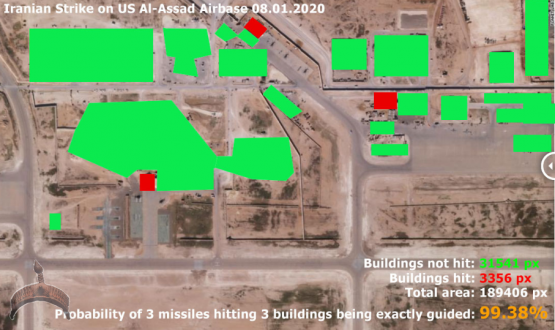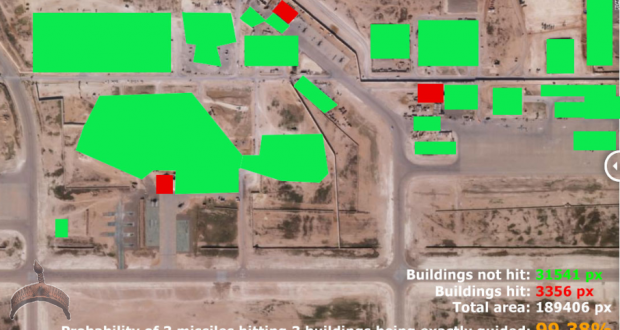First, since we have more reliable data about what happened, let me recap a few key points to being:
- It is has now become pretty clear that Iran took several steps to make sure that the US would know when and where the strike would happen. Specifically, Iran warned the Iraqi government and the Swiss diplomats who represent US interests in Iran.
- Yet, at the same time, Iran issued the strongest threat it could possibly issue: it told the US that *any* counter-strike aimed at Iran would result in a strong Iranian attack on Israel.
- The US quite clearly took the decision not to retaliate and to “forget” Trump’s promise to strike at 54 Iranian targets. I want to stress here that this was the correct decision under these circumstances.
- It also appears that the Iranians were able to somehow retrofit some kind of terminal guidance capability on missiles which originally lacked it.
- The level or precision of the strikes was absolutely superb and quite amazing.
- Trump declared that Iran decided to step down and that the US had prevailed. This notion is, of course, prima facie ridiculous, but not for folks getting their news from the corporate media.
- The Iranians declared that this specific strike was now over, but immediately added that this was only a first measure and that other would follow.
Next, I want to share a few interesting photos with you.
First, here is a photo of the base following the strikes sent to me by a friend:

Here is what my friend added: The key idea is really simple and understandable for anybody who has thought about statistics (even in an everyday context). In number terms, it’s almost like rolling a dice and getting a 6 three times in a row, because the probability of rolling a 6 with an ideal dice is 16.67% (and the probability to roll 3 sixes in a row is less than 1%) as opposed to roughly 18% probability for a hit on a building within the map area in the CNN screenshot (if we assume the missiles to be unguided within this area). To be even more precise, the probability for hitting 3 *different* buildings 3 times in a row is actually even slightly lower than 0.62%, as one would have to substract the area being hit from the total area covered by buildings (I ignored that for simplicity). A less than 1% probability for a one-off event like this means that it is really highly UNlikely – to use the British Skripal case expression in its inverted state – to have happened randomly, as we assumed in our hypothesis. Which means that the missiles were, indeed, guided, and guided very accurately, striking targets of less than ~50m size with a high degree of reliability (in this particular area 3/3, in others probably 1/1 as in the runway case, etc). Perhaps, some of them, not covered by the satellite images, missed the target, but it does not substantially change the high degree of accuracy that potential Iranian opponents within reach of these missiles will have to assume from now on. The people most interested in this were probably the Israelis, as they are probably the main potential target for this type of missile in the case of a future escalation.
Please note that neither my friend nor I are professional imagery analysts and that this is just something my friend shared with me in a private email and which I now want to share with you.
If any professional imagery analyst could either confirm/refute my friend’s conclusions, I would be most grateful.
Next, I want to share with you the following image which shows Iranian IRGC General Ali Amir Hajizadeh reviews results of recent Iranian missile strikes on Ain al-Assad airbase in Iraq during a press conference:

Clearly, the Iranians are very proud of their capability to conduct true precision strikes with an accuracy every bit as good as any Russian and/or US missile.
Finally, check out this image of the Iranian general making a press conference in front of a very interesting row of flags:

These flags include the following: The Iranian flag, the IRGC flag, the flag of IRGC’s Aerospace Force, the flag of the Lebanese Hezbollah, the Yemeni Houthi Ansarullah flag, the flag of the Iraqi Popular Mobilization Units (PMU), the Palestinian Hamas, the Afghan Liwa Fatemiyoun and the Pakistani Liwa Zainebiyoun
I find this very interesting: when Trump (or any other US politician) makes a solemn pronouncement, he typically has a number of aides, advisors, generals, Congressmen or Senators, etc. This is supposed the show the determination, resolve and unity of Uncle Shmuel, especially when Uncle Shmuel does something illegal or immoral.
The Iranian show of unity does not show more Iranians, they show the unity of all the forces in the Middle-East who have now officially united and whose goal is clear and very official: kick Uncle Shmuel out of the Middle-East.
You tell me which you find more impressive!
Next, the issue of casualties. Frankly, and while this is only my best guess, I do not believe the Iranian official casualty figures. Why? Well, first the Iranians did not try to maximize casualties (more about that option below), and they informed the US by several back-channels. But even if they had not, while the performance of the Patriot missile is pretty awful, the US does have a lot of top of the line technical intelligence means which would allow them to first detect the launch of the missiles from Iran and then to calculate their ballistic trajectory. As far as I know, now I might be wrong here, Iranian missiles do not have terminal maneuvering capability (which is different from terminal guidance). I can’t image why US commanders could not announce a incoming missile alert and then get all the local personnel into shelters. Again, I might be missing something, so if any reader can correct me, I would be grateful.
So what happened, really?
Here are a few of my current working hypotheses:
1) BOTH the USA and Iran don’t want a fullscale war. But for VERY different reasons:
- The US probably understands that it cannot win a war against Iran
- The Iranians definitely understand that while the US cannot “win”, it most definitely can kill Iranians by the thousands and inflict immense damage upon the Iranian society
2) What just took place was the single most dangerous moment since 14 April 2018 when Russia and the US came very, very close to a full-scale war. In the current situation, the US and Iran also came very, very close to a full scale war. The only reason I rank this latest crisis lower than the April 14th is that in one case we risked a planetary nuclear war whereas in this case we “only” risked a regional war which, by the way, could have seen nukes used by the US and Israel.
3) There STILL is a risk of full-scale war between the US and Iran, however, and barring a major unforeseen event, I will lower it now down from 80% to a much more tolerable 50%. Why 50%? Because Israel and the Israel Lobby will continue to push for a US attack on Iran and because while I trust the Iranians to keep their anti-US operations right below the threshold of “plausible deniability”, I cannot be sure that all Iranian allies will show similar restraint. Finally, the chances of an Israeli false flag as still sky high.
4) I expect anti-US operations to continue and even expand throughout the Middle-East. I don’t expect that these operations will be executed from Iran and I don’t expect Iranian forces to be involved, at least not officially. The Iranians know that the US has lost every single counter-insurgency war it was involved in and they know that their best chance is now to engage in all forms of asymmetrical operations.
Finally, I want to spell out what we could call the new Iranian threat.
We have to assume that Iran now has terminal guidance capability on many (most?) of its ballistic and cruise missiles and that they can destroy one specific building amongst many more buildings. Now, remember the Iranian reply that it had 35 US bases within missile range? Now imagine this first one:
- Iran fires 10-12 missile on each and every one of the 35 US bases listed and targets barracks, fuel and ammo dumps, key command posts, etc. How many casualties do you think that such a strike would result in?
Next, let’s try the same thing with Israel:
- Iran fires 2-3 missiles but carefully aims them as Israeli air force bases, personnel barracks, industrial sites (including chemical and nuclear sites, not even necessarily military ones! Dimona anybody?), the Knesset or even Bibi’s personal residence. Can you imagine the panic in Israel?
How about the KSA?
- Iran fires a large amount of missiles aimed at *truly* crippling the Saudi oil installations, National Guard barracks, airfields, etc. We already know what the Houthis could do with their very limited resources. Just imagine what Iran could do to the KSA (or the UAE and Kuwait) if it wanted to!
I think that the bottom line is clear: Iran can inflict unacceptable damage upon any party attacking it. Furthermore, and unlike having “a few” nukes, Iran has hundreds (or even thousands) of cruise missile and ballistic missiles, and you can bet that they are well distributed and well protected,as shown by this short video released by the IRGC and posted by the FARS news agency:
and that means that a disarming first strike against Iran is not possible.
There are two basic ways to respond to an attack: denial and punishment. In the first case, you have the means to deny your enemy his attack, this is what happened with the Syrians intercepted almost all the cruise missiles fired by the US. Punishment is when you cannot prevent an enemy attack, but you do have the means to inflict unacceptable damage in retaliation.
The key notion here is “unacceptable damage”.
What do you think constitutes “unacceptable damage” to the (terminally hedonistic) Israelis?
What do you think would be “unacceptable damage” to the KSA, or the world markets (especially oil)?
What about “unacceptable damage” in terms of losses for CENTCOM?
And, finally, what do you think “unacceptable damage” means to the Iranians?
There is such a huge asymmetry in how the parties to this conflict see “unacceptable damage” that is largely compensates for the asymmetry in force. Yes, sure, the US+Israel are more powerful than Iran (well, not Israel really, but Israel hiding behind the back of the US forces) but Iran is far more capable of absorbing devastating attacks than either the US or Israel.
Finally, in my last post I offered a definition of what constitutes success or failure for Iran: “anything which makes it easier for the US to remain in the Middle-East is a victory for the Empire and anything which makes it harder for the US to remain in the Middle-East is a victory for the rest of the planet.”
At this point my personal opinion is that the way the Iranians conducted their first anti-Empire operation is nothing short of brilliant: they achieved a truly phenomenal result with very little means and, most importantly, without forcing the Empire to counter-attack.
Has the US-Iran war really begun? Yes, I think so. In fact, it began in 1979, but now it has reached a qualitatively new level. The outcome of that war is absolutely evident to me. The cost, however, is not.
This have relatively cooled down, but that is an illusion and we should most definitely not take our eyes of the situation in the Middle-East: expect the initiation of asymmetrical anti-US operations very soon.
The Saker
 Ọmọ Oòduà Naija Gist | News From Nigeria | Entertainment gist Nigeria|Networking|News.. Visit for Nigeria breaking news , Nigerian Movies , Naija music , Jobs In Nigeria , Naija News , Nollywood, Gist and more
Ọmọ Oòduà Naija Gist | News From Nigeria | Entertainment gist Nigeria|Networking|News.. Visit for Nigeria breaking news , Nigerian Movies , Naija music , Jobs In Nigeria , Naija News , Nollywood, Gist and more







